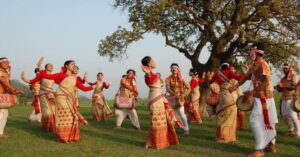Many scholars of Assamese culture considered Rati Bihu as the original form of Bihu from where modern Bihu and its types developed at a later stage. This informative blog will explain the origin of Rati Bihu, its various forms, how it is celebrated and its present status.
What is Rati Bihu
As you know, Bohag Bihu in Assam is a 7-day-long affair with elaborate rituals and traditions. Each day of these seven days is named as a separate Bihu. They are named Chot Bihu or Rati Bihu, Goru Bihu, Manuh Bihu, Gohain Bihu, Kutum Bihu, Jiyori or Senehi Bihu, Mela Bihu or Chera Bihu.
Timing of Rati Bihu
In ancient days, Raati Bihu celebrations start from the first night of the month of Chaitra (Chot in Assamese) and lasts till the commencement of Uruku (14 April). It was celebrated for a complete month or sometimes more than that. Now a days, it is celebrated symbolically for a day or two. It is performed at night, that is why it is known as Rati (Rati means night in Assamese) Bihu.
Origin of Rati Bihu
One of the most ancient manifestations of Bihu in Assam is Rati Bihu. In fact, this particular expression of Bihu predates Husori or Mukoli Bihu, being rooted in antiquity. Rati Bihu was prevalent during a much earlier era, when the Mongoloids, including the Tai-Ahoms, began commemorating festivals centered around agriculture. It was during this period that Rati Bihu emerged. The ancient populace held the belief that indulging in sensuous dance and music in the fields enhanced fertility for crop cultivation, thus laying the foundation for Bihu in such manner.
It was during the reign of Ahom King Rudra Singha (1665-1714 AD) that Rati Bihu transitioned from its rustic, rural origins, performed beneath trees, to the grandeur of the Rang-ghar courtyard, subsequently becoming a public spectacle.
How is it Celebrated?
In earlier times, the young men and women celebrated Rati Bihu separately. The Bihu celebrated by young women during night time was called Gabhoru Bihu while that of the young men was known s the Deka Bihu.
The women dancers were graceful, their moves attractive and sensuous. They would dance whole heartedly, with a free mind. It was complete merrymaking for them under the tree. The young women performed their Rati Bihu a little away from the people’s residence, at the outskirt of their village, The entry of men in this Bihu was prohibited.
While the women played and danced using instruments like Toka, Gogona and Xutuli, the men played with Dhol, Pati-tal and Pepa (made of buffalo horn).
In those times, Rati-bihu facilitated lovers to start married life. Some pairs started married life instantly after participating in Rati-bihu.
However, due to changed socio-cultural scenario at present these programme are not held in midst of nature. Of course, at present both are showcased in cultural functions organised at the occasion of Bohag Bihu. There are no separate Deka Bihu and gabhoru Bihu as well. Present celebrations involve a gathering of the local women in an open field and lighting up the torches. Men folks play an instrument made from buffalo hornpipe during the occasion.
What is Jeng Bihu?
Jeng Bihu was also held in midst of nature but at daytime, and a group of grown up girls performed Bihunach, sang Bihunam and played Toka, Gogona and Xutuli. There was no participation of menfolk in Jeng Bihu. The Assamese world Jeng means branch of Bamboo tree. In some localities Jeng was placed around the spot at which girls danced, and so, the name Jeng Bihu. In present era this name has become more popular than Rati Bihu.
Present Status of Rati Bihu
The culture of Rati Bihu was proudly preserved by the Moran tribe of Assam. It continues to be practiced in villages Dibrugarh and Tinsukia district of Assam. The rati Bihu of Kakopathar of Tinsukia district is famous for its culture. The culture of Rati Bihu has been spreading slowly to other parts of Assam.
Nowadays, Rati Bihu and Jeng Bihu is observed symbolically in open fields under trees, adorned with proper lighting and fanfare, typically for a day or two. Its spread is expanding alongside other forms of Bihu, such as Jeng Bihu.




